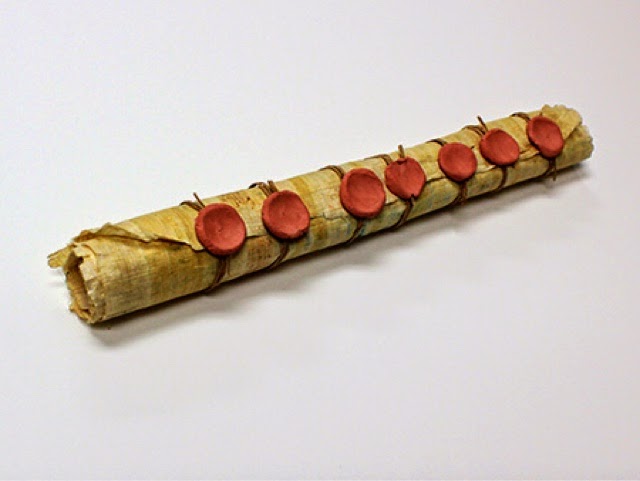
More signs appear to John as he continues to faithfully record all he witnesses—and he is witnessing much—seven angels; seven plagues; seven bowls of God’s wrath; and a place called Armageddon. Much has been written and speculated about the events in these two chapters. As always, we must keep them tied to context and while we may not be able to completely define down every symbol, we can be assured that those to whom this message was originally intended, did and could. It was spoken into their setting of Roman oppression and it offered tremendous hope—for what John is witnessing in this section is all about a final and complete judgment upon the beast that was Rome. In repeating God’s judgment process towards Rome, John continues to deliver the reassuring word to his audience—God knows those who are his; He will take care of them; And he will also take care of their enemies. Be patient and be faithful because a reckoning is coming. The visions of chapters 15-16 reinforce that message clearly.
- Seven plagues. John again sees seven angels doing God’s bidding this time possessing seven plagues. These seven plagues represent a different aspect of God’s judgment upon Rome and will be unleashed in the form of seven bowls of God’s wrath. They will also mirror to some extent both the plagues of Egypt and the consequences of the earlier seven trumpets (chapters 8-12—more on this later).
- Sea of glass mixed with fire. John again references this throne image (4:6), but this time its tranquility is now mingled with fire. Two ideas about this: Perhaps it could represent the shed blood of the nearby martyrs who already had overcome the Roman persecution or maybe it represented the fire of God’s judgment as he was now acting on the “how long” question of these martyrs (6:10).
- The Song of Moses and the Lamb. Before the actual execution of the plagues/bowls of wrath John is witnessing an interlude, which includes those martyred singing a praise to God (perhaps the “new song” from 14:3), which was reminiscent of the song sung by Moses and Israel after crossing the Red Sea (Exodus 15). Like then it is a song of deliverance and recognition—a combination of praise from the Psalms, Moses and the prophets—of who God is and how all nations (including Rome like Egypt before) will submit to him.
- Tent of the tabernacle. Again, John’s attention is drawn here (11:9) representing where God dwells. Out of it emerge the angels in priestly garbs indicating that their mission emanates directly from God and they serve as his servant messengers. As they are given the bowls filled with God’s wrath/the seven plagues God’s power and presence is everywhere evident. It is about to be on—God’s full and complete (represented again in all of the latest sets of sevens) reckoning on Rome.
- The seven bowls. One important point to note is—while God’s judgement has been previously conveyed by John through different symbolism, the judgment depicted here is more thorough in design. Recall before in the trumpet judgements, they were portrayed as only affecting a segment of the people (one-third) and stood more as calls to repentance. Here the bowl judgments seem to represent the time when all hope of any repentance is passed and God’s full and final wrath is poured out upon Rome. Also, as previously mentioned, there are similarities to both those trumpet judgments and especially the Egyptian plagues in that every aspect of Roman life will be touched—the spiritual, political, physical and the moral.
- First bowl. Immediately God’s wrath is felt personally upon all who have the beast’s mark. No mistake that the first plague (unlike those of Egypt—6th plague or the trumpets—5th) fell directly upon people. They had sown corruption in the flesh and now flesh was being corrupted. Of course, this is not to be taken literally, but very much is a statement about how the corruption that was Rome would eventually consume her.
- Second bowl. The sea does not escape—turns into blood (parallels Exodus 7:20-24 and the second trumpet—8:8-9). Whatever touches/depends upon the sea is destroyed.
- Third bowl. All water/the fresh water is also touched and became blood. This carries the idea that those who had the beast’s mark; those who had shed the blood of God’s people now could not escape it. This represented God’s “true and just” judgments.
- Fourth bowl. With no more water to drink, the scorching intensity of the sun next was poured out upon them—carrying with it the familiar image of fiery judgment. Significantly here—these judgments do not result in repentance—only doubling-down of resistance (again reflective of Egypt).
- Fifth bowl. So, the next bowl is directed to the very center of power—the throne of the beast (God’s power is far greater even than the beast’s), which resulted in total darkness across the kingdom, but even so, while still being afflicted by the very first plague of sores and in agony—no repentance happens.
- Sixth bowl. It is poured out upon the Euphrates River, which dries up, opening up a path for “the kings of the East.” Could be an illusion to the capture of Babylon by the Mede king Darius (Daniel 5:24-30) after he diverted the waters of the Euphrates and then invaded through it. Does this indicate perhaps that Rome will also eventually likewise fall to invading enemies from the east as a part of God’s judgment. Or is it’s symbolic of sunrising Christ and his army invading and conquering at Armageddon?
- Three frogs. Or evil spirits accompany the sixth bowl. They emerged from (vomited by is the best rendering) the dragon (Satan), the beast (Rome) and the false prophet (perhaps here, the emperor). Perhaps the best way to understand this vision is to see the frogs as manifestations of all of the combined demonic power, deception, propaganda and lies that Rome had mustered up in opposition to God and his people. They gather all of their combined forces together, call upon all of their allies in preparation to once more attempt to defeat God and his kingdom—to which Christ responds that he will come when and in ways they do not expect to answer their challenge—so to his followers he urges constant alertness and readiness.
- Armageddon. Here it is—the final battle between the evil forces of Rome and the righteous forces of God and at long last God’s people will be completely and fully avenged and vindicated. It will happen at a place called Armageddon (Har meaning mountain and magedo meaning the name Megiddo). This is a reference to the ancient site of Megiddo where many Hebrew battles were fought (Judges 4-5; 7:1; 1 Samuel 31:1-6; 2 Kings 9:27; 23:29, etc.) Much speculation then has been made as to its meaning including a futurist rendering that sees a final climatic battle yet to take place there between the various (and changing) forces of good and evil embodied by Gog. While John does borrow images from Ezekiel’s portrayal of God’s battle with an enemy then identified as Gog (38-39), nowhere in this text is the idea of a battle occurring beyond the immediate context of this letter—and the battle here in the text is certainly symbolic. The use of Megiddo was a fitting symbol for John to represent “the worldwide distress of righteousness and evil engaged in deadly combat.” Armageddon then is only symbolic of the final battle portrayed by John that ultimately results in the complete fall and ultimate end of the Roman oppression for Christians. Any other way of considering this—especially that of an actual physical battle would be wildly inconsistent with not just their immediate circumstances but also of the way of the slain Lamb. His army simply did not respond that way.
- Seventh bowl. “It is done.” No better way to phrase it. The last plague drops and its destruction is so complete and it demolishes what is left of Babylon into three parts—even touching the outlying areas (islands) of the empire—bringing more misery and death upon the unrepentant followers of the beast in the form of hail. Perhaps only the final judgment of all of mankind will surpass this judgment in intensity. All together the plagues/bowls/Armageddon represented the same thing—God bringing an end to the suffering of his people by destroying Satan’s alliance with the Rome.



 Posted by dannydodd
Posted by dannydodd 


